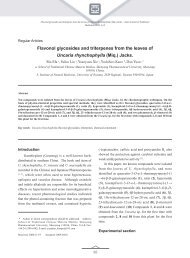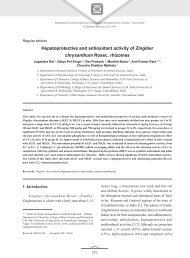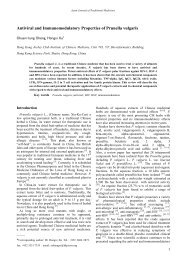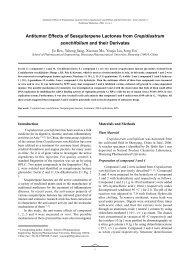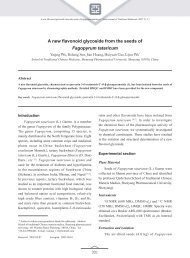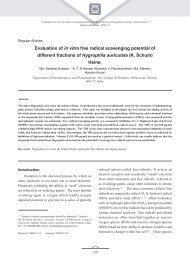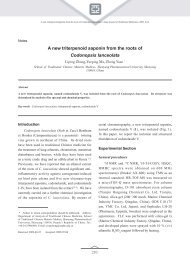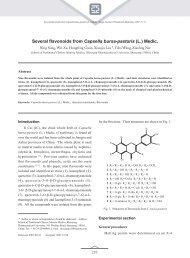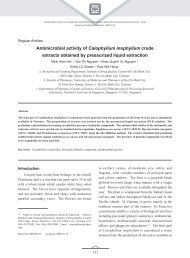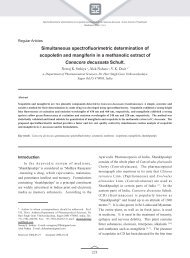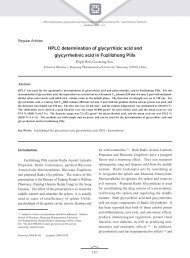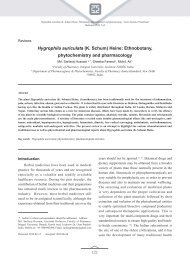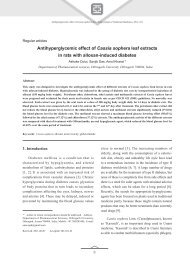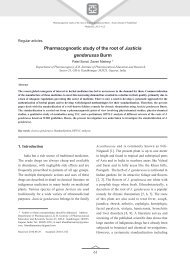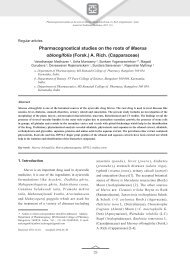Antimicrobial activity of Tinospora cordifolia: an ethnomedicinal plant
Antimicrobial activity of Tinospora cordifolia: an ethnomedicinal plant
Antimicrobial activity of Tinospora cordifolia: an ethnomedicinal plant
You also want an ePaper? Increase the reach of your titles
YUMPU automatically turns print PDFs into web optimized ePapers that Google loves.
<strong>Antimicrobial</strong> <strong>activity</strong> <strong>of</strong> <strong>Tinospora</strong> <strong>cordifolia</strong> / Asi<strong>an</strong> Journal <strong>of</strong> Traditional Medicines, 2012, 7(2)<br />
Regular articles<br />
<strong>Antimicrobial</strong> <strong>activity</strong> <strong>of</strong> <strong>Tinospora</strong> <strong>cordifolia</strong>: <strong>an</strong><br />
<strong>ethnomedicinal</strong> pl<strong>an</strong>t<br />
Veeramuthu Duraip<strong>an</strong>diy<strong>an</strong> c , Savarimuthu Ignacimuthu a *, Kedike Balakrishna b ,<br />
, , ,<br />
Naif Abdullah AL-Harbi , c<br />
a. Division <strong>of</strong> Ethnopharmacology, Entomology Research Institute, Loyola College,<br />
Chennai-600 034, India<br />
b. Captain Srinivasa Murti Drug Research Institute for Ayurveda <strong>an</strong>d Siddha, Arumbakkam,<br />
Chennai-600 106, Tamil Nadu, India<br />
c. Department <strong>of</strong> Bot<strong>an</strong>y <strong>an</strong>d Microbiology, Addiriyah Chair for Environmental Studies<br />
Abstract<br />
Various org<strong>an</strong>ic solvent extracts <strong>of</strong> <strong>Tinospora</strong> <strong>cordifolia</strong> stem were tested against some Gram-positive <strong>an</strong>d Gram-negative bacteria<br />
<strong>an</strong>d fungi. Antibacterial <strong>activity</strong> <strong>of</strong> crude extract was carried out using disc diffusion method <strong>an</strong>d MIC <strong>of</strong> isolated compound was<br />
tested by broth microdilution method. The <strong>an</strong>tifungal <strong>activity</strong> was carried out using broth microdilution method. Crude eth<strong>an</strong>olic<br />
extract showed good <strong>an</strong>tibacterial <strong>an</strong>d <strong>an</strong>tifungal <strong>activity</strong> against tested microbes. A compound [(5R, 10R)-4R, 8R-Dihydroxy-2S,<br />
3R:15, 16-diepoxycleroda-13(16), 17, 12S, 18, 1S-dilactone] was isolated from eth<strong>an</strong>olic extract. The compound also showed good<br />
<strong>activity</strong> against bacteria <strong>an</strong>d fungi. The lowest MIC values were seen against Bacillus subtilis (200 µg/ml), Enterococcus faecalis<br />
(125 µg/ml) Trichophyton simii (31.25 µg/ml), Trichophyton rubrum 57 (62.5 µg/ml) <strong>an</strong>d Trichophyton rubrum 296 (62.5 µg/ml).<br />
The crude eth<strong>an</strong>ol extract <strong>of</strong> <strong>Tinospora</strong> <strong>cordifolia</strong> <strong>an</strong>d isolated compound showed <strong>activity</strong> against tested bacteria <strong>an</strong>d fungi.<br />
Key words: <strong>an</strong>tibacterial, <strong>an</strong>tifungal, <strong>Tinospora</strong> <strong>cordifolia</strong>, clerod<strong>an</strong>e diterpene<br />
1 Introduction<br />
India has a rich flora <strong>of</strong> medicinal pl<strong>an</strong>t species<br />
that are widely distributed throughout the country.<br />
They produce m<strong>an</strong>y unusual secondary metabolites<br />
which are biologically active. Despite the existence<br />
<strong>of</strong> a wide variety <strong>of</strong> <strong>an</strong>tibacterial agents the search<br />
for new ones is <strong>of</strong> great import<strong>an</strong>ce. Microbial<br />
* Author to whom correspondence should be addressed. Address:<br />
Entomology Research Institute, Loyola College, Nungambakkam,<br />
Chennai 600 034, Tamil Nadu, India; Tel: +91-44-2817 8348; Fax:<br />
+91-44-2817 5566; E-mail: entolc@hotmail.com<br />
Received: 2010-12-24 Accepted: 2012-03-02<br />
infections are the cause <strong>of</strong> a large burden <strong>of</strong><br />
diseases <strong>an</strong>d bacteria are listed in the first position<br />
among the common microorg<strong>an</strong>isms responsible<br />
for opportunistic diseases occurring in association<br />
with AIDS. Therapy <strong>of</strong> bacterial infections is a<br />
frequent problem due to the emergence <strong>of</strong> bacterial<br />
strains resist<strong>an</strong>t to numerous <strong>an</strong>tibiotics. In India<br />
catheters <strong>an</strong>d lung infections caused by Gramnegative<br />
org<strong>an</strong>isms such as Klebsiella, Pseudomonas<br />
<strong>an</strong>d Enterococci are predomin<strong>an</strong>t. Nosocomial<br />
pneumonia is most common in the surgical intensive<br />
units. The search for natural products to cure disease<br />
represents <strong>an</strong> area <strong>of</strong> great interest in which pl<strong>an</strong>ts<br />
have been the most import<strong>an</strong>t sources. In the Indi<strong>an</strong><br />
59
<strong>Antimicrobial</strong> <strong>activity</strong> <strong>of</strong> <strong>Tinospora</strong> <strong>cordifolia</strong> / Asi<strong>an</strong> Journal <strong>of</strong> Traditional Medicines, 2012, 7(2)<br />
traditional medicine, the use <strong>of</strong> pl<strong>an</strong>t is a widespread<br />
practice among tribal <strong>an</strong>d rural communities. More<br />
<strong>an</strong>d more people in developing countries utilize<br />
traditional medicine for their major primary health<br />
care needs [1, 2]<br />
Natural products derived from higher pl<strong>an</strong>ts play<br />
<strong>an</strong> import<strong>an</strong>t role as useful tools in pharmacological<br />
studies. With the technological adv<strong>an</strong>cement <strong>of</strong><br />
science the isolation, identification <strong>an</strong>d elucidation<br />
<strong>of</strong> chemical principles from natural sources have<br />
become much simpler <strong>an</strong>d have contributed<br />
signific<strong>an</strong>tly to the development <strong>of</strong> new drugs from<br />
medicinal pl<strong>an</strong>ts [3].<br />
<strong>Tinospora</strong> <strong>cordifolia</strong> (Willd) Miers (Guduchi)<br />
belonging to Menisoermaceae (Family) is<br />
distributed throughout the plains <strong>of</strong> India. In folk<br />
<strong>an</strong>d tribal medicine the whole pl<strong>an</strong>t <strong>an</strong>d the powder<br />
<strong>of</strong> leaves, stem bark <strong>an</strong>d roots <strong>of</strong> T. <strong>cordifolia</strong><br />
are used to treat various ailments such as fever,<br />
jaundice, diarrhea, dysentery, general debility,<br />
cough, asthma, skin diseases, fracture, bites <strong>of</strong><br />
poisonous insect <strong>an</strong>d eye disorders [4]. In Ayurvedic<br />
medicine it is used for the treatment <strong>of</strong> liver <strong>an</strong>d<br />
intestinal disorders [5]. Pl<strong>an</strong>t stem possess immunomodulatory<br />
[6], hepatoprotective [7], <strong>an</strong>tipyretic<br />
[8], <strong>an</strong>tiulcer [9] <strong>an</strong>d <strong>an</strong>tic<strong>an</strong>cer [10] activities.<br />
<strong>Tinospora</strong> <strong>cordifolia</strong> has been clinically used to treat<br />
jaundice, rheumatoid arthritis <strong>an</strong>d diabetes [11]. The<br />
species is rich in clerod<strong>an</strong>e derived diterpinoids [12].<br />
The clerod<strong>an</strong>e diterpenoids comprise a large class<br />
<strong>of</strong> natural products with wide biological activities<br />
[13, 14]. The present study was undertaken to assess<br />
the <strong>an</strong>tibacterial <strong>an</strong>d <strong>an</strong>tifungal <strong>activity</strong> <strong>of</strong> various<br />
org<strong>an</strong>ic <strong>an</strong>d aqueous extracts <strong>of</strong> T. <strong>cordifolia</strong> stem<br />
<strong>an</strong>d <strong>an</strong> isolated compound.<br />
2 Materials <strong>an</strong>d methods<br />
2.1 Pl<strong>an</strong>t material<br />
Stems <strong>of</strong> <strong>Tinospora</strong> <strong>cordifolia</strong> were collected<br />
from Th<strong>an</strong>darai, K<strong>an</strong>chipuram distict, Tamil Nadu,<br />
India. The pl<strong>an</strong>t was identified <strong>an</strong>d confirmed by a<br />
taxonomist from the Department <strong>of</strong> Bot<strong>an</strong>y, Loyola<br />
College. Chennai <strong>an</strong>d a voucher specimen (ERIC-D-<br />
45) is deposited at the herbarium <strong>of</strong> Entomology<br />
Research Institute, Loyola College,<br />
2.2 Preparation <strong>of</strong> crude extracts<br />
One kg <strong>of</strong> powder was extracted with hex<strong>an</strong>e<br />
for a period <strong>of</strong> 48 hours. The extract was filtered<br />
through a Buchner funnel with Whatm<strong>an</strong> number 1<br />
filter paper. The filtrate was evaporated to dryness<br />
under reduced pressure using rotary evaporator<br />
at 40°C. The remains <strong>of</strong> the pl<strong>an</strong>t material were<br />
extracted with ethyl acetate, eth<strong>an</strong>ol, meth<strong>an</strong>ol<br />
<strong>an</strong>d water sequentially in a similar m<strong>an</strong>ner.<br />
2.3 Isolation <strong>an</strong>d identification <strong>of</strong> active<br />
compound<br />
Since the eth<strong>an</strong>ol extract showed promising<br />
<strong>an</strong>tibacterial <strong>an</strong>d <strong>an</strong>tifungal <strong>activity</strong>, it (25 g) was<br />
subjected to column chromatography over silica<br />
gel (200 g-Acme’s silica gel, 100–200 mesh)<br />
fractionation was followed by TLC <strong>an</strong>d similar<br />
fractions were pooled together. The fractions were<br />
then subjected to <strong>an</strong>timicrobial <strong>activity</strong> <strong>an</strong>d the<br />
active fraction was located. From the active fraction<br />
the pure compound was isolated <strong>an</strong>d identified.<br />
2.4 Test org<strong>an</strong>isms<br />
The following bacteria <strong>an</strong>d fungi were used<br />
for the experiment. Bacteria: Bacillus subtilis<br />
MTCC 441, Enterococcus faecalis ATCC 29212,<br />
Staphylococcus aureus ATCC 25923, Escherichia<br />
coli ATCC 25922, Klebsiella pneumoniae<br />
ATCC 15380, Proteus vulgaris MTCC 1771.<br />
Fungi: T. rubrum MTCC 296, T. rubrum 57/01,<br />
T. mentagrophytes 66/01, T. simii 110/02,<br />
Epidermophyton floccosum 73/01, Scopulariopsis<br />
sp. 101/01 Aspergillus niger MTCC 1344, Botyritis<br />
60
<strong>Antimicrobial</strong> <strong>activity</strong> <strong>of</strong> <strong>Tinospora</strong> <strong>cordifolia</strong> / Asi<strong>an</strong> Journal <strong>of</strong> Traditional Medicines, 2012, 7(2)<br />
cinerea, Curvularia lunata 46/0, Magnoporthe<br />
grisea. All the cultures were obtained from the<br />
Department <strong>of</strong> Microbiology, Christi<strong>an</strong> Medical<br />
College, Vellore, Tamil Nadu, India.<br />
2.5 Preparation <strong>of</strong> inoculums<br />
Bacterial inoculum was prepared by growing<br />
cells in Mueller Hinton Broth (Himedia) for 24 h<br />
at 37°C. These cell suspensions were diluted with<br />
sterile MHB to provide initial cell counts <strong>of</strong> about<br />
10 4 CFU/ml. The filamentous fungi were grown on<br />
Sabouraud Dextrose Agar (SDA) sl<strong>an</strong>ts at 28 o C for<br />
10 days <strong>an</strong>d the spores were collected using sterile<br />
doubled distilled water <strong>an</strong>d homogenized. Yeast was<br />
grown on Sabouraud Dextrose Broth (SDB) at 28 o C<br />
for 48 h.<br />
2.6 Antibacterial assay (Disc diffusion method)<br />
Antibacterial <strong>activity</strong> was carried out using discdiffusion<br />
method [16]. Petri plates were prepared<br />
with 20 ml <strong>of</strong> sterile Mueller Hinton Agar (MHA)<br />
(Hi-media, Mumbai). The test cultures were swabbed<br />
on the top <strong>of</strong> the solidified media <strong>an</strong>d allowed to<br />
dry for 10 min. The tests were conducted at three<br />
different concentrations <strong>of</strong> the crude extract (5 mg,<br />
2.5 mg <strong>an</strong>d 1.25 mg per disc). The loaded discs were<br />
placed on the surface <strong>of</strong> the medium <strong>an</strong>d left for 30<br />
min at room temperature for compound diffusion.<br />
Negative control was prepared using respective<br />
solvent. Streptomycin (10 µg/disc) was used as<br />
positive control. The plates were incubated for 24 h<br />
at 37 o C for bacteria <strong>an</strong>d 48 h at 27 o C for fungi. Zones<br />
<strong>of</strong> inhibition were recorded in millimeters <strong>an</strong>d the<br />
experiment was repeated twice.<br />
2.7 Antifungal <strong>activity</strong> <strong>an</strong>d minimum inhibitory<br />
concentration<br />
The <strong>an</strong>tifungal <strong>activity</strong> <strong>an</strong>d minimum<br />
inhibitory concentration (MIC) were performed<br />
according to the st<strong>an</strong>dard reference method [17].<br />
The extracts <strong>an</strong>d compound were dissolved in<br />
water +2% Dimethyl Sulfoxide (DMSO). The<br />
initial concentration <strong>of</strong> extracts was 1 mg/ml<br />
<strong>an</strong>d for compound it was 250 µg/ml. The initial<br />
test concentration was serially diluted two-fold.<br />
Each well was inoculated with 5 µl <strong>of</strong> suspension<br />
containing 10 8 CFU/ml <strong>of</strong> bacteria <strong>an</strong>d 10 4 spore/<br />
ml <strong>of</strong> fungi, respectively. Five μl <strong>of</strong> tested broth<br />
was placed on the sterile MHA plates for bacteria <strong>an</strong>d<br />
incubated at respective temperature. The <strong>an</strong>tifungal<br />
agents Ketoconazole <strong>an</strong>d Fluconazole <strong>an</strong>d <strong>an</strong>tibacterial<br />
agents Streptomycin <strong>an</strong>d Cipr<strong>of</strong>loxacin were included<br />
in the assays as positive controls. The fungal plates<br />
were incubated for 24, 48 or 72 h at 27°C up to 9 days<br />
while bacterial plates were incubated for 24 h at 37°C.<br />
MIC was defined as the lowest extract concentration<br />
showing no visible fungal growth after incubation<br />
time. The MIC for bacteria was determined as the<br />
lowest concentration <strong>of</strong> the compound inhibiting the<br />
visual growth <strong>of</strong> the test cultures on the agar plate.<br />
3 Results <strong>an</strong>d discussion<br />
The yield <strong>of</strong> hex<strong>an</strong>e, ethyl acetate, eth<strong>an</strong>ol,<br />
meth<strong>an</strong>ol <strong>an</strong>d water extracts from stems <strong>of</strong> T.<br />
<strong>cordifolia</strong> were 15 g for hex<strong>an</strong>e, 20 g for ethyl<br />
acetate, 25 g for eth<strong>an</strong>ol, 40 g for meth<strong>an</strong>ol <strong>an</strong>d<br />
5 g for water.The different solvent extracts <strong>of</strong><br />
T. <strong>cordifolia</strong> were tested against selected Grampositive<br />
<strong>an</strong>d Gram-negative pathogenic bacteria. The<br />
results are presented in Table 1. Hex<strong>an</strong>e extract did<br />
not show <strong>an</strong>y <strong>activity</strong> against tested bacteria for all<br />
tested concentrations. Ethyl acetate extract inhibited<br />
the growth <strong>of</strong> S. aureus (10 mm), S. typhi (9mm)<br />
<strong>an</strong>d P. vulgaris (13 mm) at higher concentration<br />
<strong>of</strong> 5mg/disc. Eth<strong>an</strong>ol extract showed promising<br />
<strong>an</strong>tibacterial <strong>activity</strong> for all tested bacteria such as<br />
S. aureus (8 mm), B. subtilis (9mm), E. faecalis<br />
(9 mm), E. coli (9 mm), S. typhi (8 mm) <strong>an</strong>d P.<br />
vulgaris (8 mm) at lowest concentrations (Table<br />
1). Meth<strong>an</strong>ol extract showed moderate <strong>activity</strong><br />
against S. aureus, B. subtilis, E. faecalis, E. coli<br />
61
<strong>Antimicrobial</strong> <strong>activity</strong> <strong>of</strong> <strong>Tinospora</strong> <strong>cordifolia</strong> / Asi<strong>an</strong> Journal <strong>of</strong> Traditional Medicines, 2012, 7(2)<br />
Table 1. Antibacterial <strong>activity</strong> <strong>of</strong> different solvent extracts <strong>of</strong> T. <strong>cordifolia</strong> stem<br />
Extracts<br />
Conc.<br />
Mg/ disc<br />
Disc diffusion method (inhibition zone, mm)<br />
S.a B.s E.f E.c S.t K.p P.v<br />
Hex<strong>an</strong>e extract 1.25 - - - - - -<br />
2.5 - - - - - - -<br />
5 - - - - - - -<br />
Ethyl acetate extract 1.25 - - - - - - -<br />
2.5 - - - - - - -<br />
5 10 - - - 9 13<br />
Eth<strong>an</strong>ol extract 1.25 8 9 9 9 8 - 8<br />
2.5 10 14 12 11 9 - 14<br />
5 12 16 15 14 12 - 16<br />
Meth<strong>an</strong>ol extract 1.25 - - - - - - -<br />
2.5 10 - 9 - - - 10<br />
5 13 10 11 11 - - 12<br />
Water extract 1.25 - - - - - - -<br />
2.5 - - - - - - -<br />
5 - 9 9 - - - -<br />
Streptomycin 10µg 12 13 12 13 nt 11 nt<br />
Cipr<strong>of</strong>loxacin 5 µg 20 30 16 25 nt 28 nt<br />
-, no <strong>activity</strong>; S.a - Staphylococcus aureus; B.s - B. subtilis; E.f- Enterococcus faecalis; E.c - Escherichia coli; K.p – Klebsiella<br />
pneumoniae; P.v- Proteus vulgaris; Streptomycin <strong>an</strong>d Cipr<strong>of</strong>loxacin- Control <strong>an</strong>tibiotics<br />
<strong>an</strong>d P. vulgaris but did not show <strong>activity</strong> against S.<br />
typhi <strong>an</strong>d P. vulgaris. Water extract inhibited only<br />
the growth <strong>of</strong> B. subtilis (9 mm) <strong>an</strong>d E. faecalis<br />
(9 mm) at higher concentrations. The maximum<br />
inhibition zones were observed in eth<strong>an</strong>ol extract<br />
against B. subtilis (16mm), E. faecalis (15 mm), E.<br />
coli (14 mm) <strong>an</strong>d P. vulgaris (16mm). The lowest<br />
MIC values were recorded in eth<strong>an</strong>ol extract against<br />
S. aureus (0.315 mg/ml), B. subtilis (0.315 mg/ml),<br />
E. faecalis (0.315 mg/ml) <strong>an</strong>d P. vulgaris (0.315<br />
mg/ml) (Table 2). Antifungal <strong>activity</strong> <strong>of</strong> T. <strong>cordifolia</strong><br />
stems <strong>of</strong> hex<strong>an</strong>e, ethyl acetate, eth<strong>an</strong>ol, meth<strong>an</strong>ol<br />
<strong>an</strong>d water extracts were tested against fungi <strong>an</strong>d<br />
the results are presented in Table 3. Hex<strong>an</strong>e, ethyl<br />
acetate <strong>an</strong>d eth<strong>an</strong>ol extracts showed promising<br />
<strong>an</strong>tifungal <strong>activity</strong> against T. rubrum 296, T. rubrum,<br />
T. mentagrophytes, T. simii <strong>an</strong>d E. floccosum. Water<br />
<strong>an</strong>d meth<strong>an</strong>ol extracts did not show <strong>an</strong>tifungal<br />
<strong>activity</strong>.<br />
<strong>Antimicrobial</strong> screening results indicated that<br />
both <strong>an</strong>tibacterial <strong>an</strong>d <strong>an</strong>tifungal activities were<br />
observed in eth<strong>an</strong>ol extract <strong>of</strong> T. <strong>cordifolia</strong>. The<br />
active compound after bioassay guided fractionation<br />
was identified as 8-hydroxy arc<strong>an</strong>gelisin Structure<br />
o f ( 5 R , 1 0 R ) - 4 R , 8 R - d i h y d r o x y - 2 S , 3 R : 1 5 ,<br />
16-diepoxycleroda-13(16), 17, 12S, 18, 1S-dilactone<br />
(clerod<strong>an</strong>e diterpene) (Fig. 1). The compound which<br />
is a clerod<strong>an</strong>e diterpene has been previously reported<br />
by us as <strong>an</strong>tic<strong>an</strong>cer compound against hepatocellular<br />
carcinoma [15].<br />
Antic<strong>an</strong>cer property <strong>of</strong> this compound has been<br />
reported by Dh<strong>an</strong>asekar<strong>an</strong> et al [15]. <strong>Antimicrobial</strong><br />
<strong>activity</strong> <strong>of</strong> this compound is given in Table 2<br />
<strong>an</strong>d 3. The compound inhibited the growth <strong>of</strong> B.<br />
subtilis (200 µg/ml), E. faecalis (125 µg/ml), E.<br />
62
<strong>Antimicrobial</strong> <strong>activity</strong> <strong>of</strong> <strong>Tinospora</strong> <strong>cordifolia</strong> / Asi<strong>an</strong> Journal <strong>of</strong> Traditional Medicines, 2012, 7(2)<br />
Table 2. MIC <strong>of</strong> T. <strong>cordifolia</strong> stem extracts <strong>an</strong>d isolated compound against bacteria<br />
Microorg<strong>an</strong>ism<br />
MIC (mg/ml)<br />
MIC (µg/ml)<br />
H E Et Me W C Cfl Strep (µg/ml)<br />
Staphylococcus aureus >5.0 2.5 0.315 2.5 >5.0 >200 5.0 >5.0 0.315 0.625 5.0 200 5.0 >5.0 0.315 1.25 5.0 125 6.25 25<br />
Escherichia coli >5.0 >5.0 1.25 2.5 >5.0 200 5.0 5.0 1.25 >5.0 >5.0 >200 nt 25<br />
Klebsiella pneumoniae >5.0 >5.0 >5.0 >5.0 >5.0 >200 5.0 2.5 0.315 1.25 >5.0 125 nt nt<br />
nt, not tested; H- Hex<strong>an</strong>e extract; E- Ethyl acetate extract; Et- Eth<strong>an</strong>ol extract; Me- Meth<strong>an</strong>ol extract; W-Water extract; C-<br />
Isolated Compound; Strept- Streptomycin; Cfl- Cipr<strong>of</strong>loxacin (Control <strong>an</strong>tibiotic for bacteria)<br />
Table 3: MIC <strong>of</strong> T. <strong>cordifolia</strong> stem extracts <strong>an</strong>d isolated compound against fungi<br />
Tested org<strong>an</strong>ism<br />
Dermatophytes<br />
Minimum inhibitory concentration (mg/ml)<br />
H E Et Me W C (µg/ml) Fl (µg/ml)<br />
Trichophyton rubrum 296 0.125 0.250 0.125 1.0 >1.0 62.5 1.0 >1.0 62.5 25<br />
Trichophyton mentagrophytes 0.250 0.5 0.250 >1.0 >1.0 125 25<br />
Trichophyton simii 0.250 0.5 0.625 >1.0 >1.0 31.2 1.0 >1.0 125 12.5<br />
Scopulariopsis sp. >1.0 >1.0 >1.0 >1.0 >1.0 >200 1.0 >1.0 >1.0 >1.0 >1.0 >200 100<br />
Botyritis cinerea >1.0 >1.0 >1.0 >1.0 >1.0 >200 -<br />
Curvularia lunata >1.0 >1.0 >1.0 >1.0 >1.0 >200 1.0 >1.0 200 -<br />
-, no <strong>activity</strong>; H- Hex<strong>an</strong>e extract; E- Ethyl acetate extract; Et- Eth<strong>an</strong>ol extract; Me- Meth<strong>an</strong>ol extract; W- Water extract; C-<br />
Isolated Compound; Fluconazole Control <strong>an</strong>tibiotic for fungi.<br />
coli (200 µg/ml) <strong>an</strong>d P. vulgaris (125 µg/ml). The<br />
compound also inhibited the growth <strong>of</strong> T. rubrum<br />
57 (62.5 µg/ml), T. rubrum 296 (62.5 µg/ml), T.<br />
mentagrophytes (125 µg/ml), T. simii (31.2 µg/ml),<br />
E. floccosum (125 µg/ml) <strong>an</strong>d M. grisea (200 µg/<br />
ml). The compound did not show <strong>activity</strong> against<br />
S. aureus <strong>an</strong>d S. typhi. This compound has not been<br />
reported previously for <strong>an</strong>timicrobial <strong>activity</strong>. The<br />
search for natural products to cure disease represents<br />
<strong>an</strong> area <strong>of</strong> great interest in which pl<strong>an</strong>ts have<br />
been the most import<strong>an</strong>t sources. In recent years<br />
<strong>an</strong>timicrobial properties <strong>of</strong> Indi<strong>an</strong> medicinal pl<strong>an</strong>ts<br />
have been increasingly reported [18-20]. Over the<br />
years there have been several studies documenting<br />
the <strong>an</strong>tibacterial properties <strong>of</strong> pl<strong>an</strong>ts from India <strong>an</strong>d<br />
Tamil Nadu [21-28]<br />
The crude extracts <strong>of</strong> T. <strong>cordifolia</strong> stem showed<br />
<strong>activity</strong> against bacteria <strong>an</strong>d fungi. Among the<br />
tested extracts eth<strong>an</strong>ol extract showed good <strong>activity</strong><br />
against both bacteria <strong>an</strong>d fungi. Aqueous, eth<strong>an</strong>ol<br />
<strong>an</strong>d chlor<strong>of</strong>orm crude extract <strong>of</strong> T. <strong>cordifolia</strong><br />
63
<strong>Antimicrobial</strong> <strong>activity</strong> <strong>of</strong> <strong>Tinospora</strong> <strong>cordifolia</strong> / Asi<strong>an</strong> Journal <strong>of</strong> Traditional Medicines, 2012, 7(2)<br />
The present work supports the claim in the<br />
traditional medicine that the pl<strong>an</strong>t c<strong>an</strong> be used in<br />
the treatment <strong>of</strong> various infectious diseases as fever,<br />
diarrhea, dysentery, cough etc. which are <strong>of</strong> bacterial<br />
origin <strong>an</strong>d skin diseases caused by fungi.<br />
stems showed <strong>an</strong>tibacterial <strong>activity</strong> against E.<br />
coli, P. vulgaris, E. faecalis. S. typhi <strong>an</strong>d Serratia<br />
marcesecens [29]. Dhar et al. [30] reported that<br />
eth<strong>an</strong>olic stem extract <strong>of</strong> T. <strong>cordifolia</strong> showed<br />
<strong>an</strong>tiviral <strong>activity</strong> against R<strong>an</strong>ikhet diseases. The<br />
active compound was isolated from eth<strong>an</strong>ol<br />
extract. Isolated compound showed <strong>activity</strong><br />
against bacteria <strong>an</strong>d fungi. The lowest MIC values<br />
were observed against E. faecalis (125 µg/ml)<br />
<strong>an</strong>d P. vulgaris (125 µg/ml). The compound also<br />
showed <strong>activity</strong> against fungi; the lowest MIC<br />
values were seen against T. simii, T. rubrum 57 <strong>an</strong>d<br />
T. rubrum (296). The fact that diterpenoids seem to<br />
be key compounds in the <strong>an</strong>timicrobial <strong>activity</strong> <strong>of</strong><br />
the resinous exudates from pl<strong>an</strong>ts has been recently<br />
documented with a comparative <strong>an</strong>timicrobial study<br />
<strong>of</strong> several pl<strong>an</strong>ts in which the diterpenoids are the<br />
principal components in these extracts [31]. Zagodaspols<br />
et al. [32] reported that four diterpenes were<br />
isolated from the stem bark <strong>of</strong> Mitrephora celebica<br />
through bioassay-guided fractionation. These<br />
compounds were responsible for the <strong>an</strong>timicrobial<br />
<strong>activity</strong> <strong>of</strong> the pl<strong>an</strong>t against methicillin-resist<strong>an</strong>t<br />
Staphylococcus aureus <strong>an</strong>d Mycobacterium<br />
smegmatis.<br />
Reference<br />
[1] Farnsworth NR. Ethnopharmacology <strong>an</strong>d future drug<br />
development: the North Americ<strong>an</strong> experience. J<br />
Ethnopharmacol, 1993, 38: 145-152.<br />
[2] Houghton PJ. The role <strong>of</strong> pl<strong>an</strong>ts in traditional medicine<br />
<strong>an</strong>d current therapy. J Alternat Complement Med. 1995,<br />
1: 131-143.<br />
[3] Cox PA. Ethnopharmacology <strong>an</strong>d the search for new<br />
Fig. 1. Structure <strong>of</strong> (5R, 10R)-4R, 8R-dihydroxy-2S, 3R:<br />
Fig.1.Structure <strong>of</strong> (5R,10R)-4R,8R-dihydroxy-2S,3R:15, 16-diepoxycleroda-<br />
drugs. In Bioactive compounds from pl<strong>an</strong>ts (Eds.D.J.<br />
13(16),17,12S,18,1S-dilactone<br />
15, 16-diepoxycleroda-13(16), 17, 12S, 18, 1S-dilactone<br />
(clerod<strong>an</strong>e diterpene).<br />
(clerod<strong>an</strong>e diterpene)<br />
Chadwick <strong>an</strong>d J.Marsh).Ciba Foundation Symposium<br />
154, John Wiley & Sons, Chickester, 1990, 40-55.<br />
Antic<strong>an</strong>cer <strong>of</strong> this compound has been reported by Dh<strong>an</strong>asekar<strong>an</strong> et al.[15]. <strong>Antimicrobial</strong> [4] Singh J, Sinha K, Sharma A, Mishra NP, Kh<strong>an</strong>uja SPS.<br />
Traditional uses <strong>of</strong> <strong>Tinospora</strong> <strong>cordifolia</strong> (Guduchi). J<br />
<strong>activity</strong> <strong>of</strong> this compound is given in table 2 <strong>an</strong>d 3. The compound inhibited the growth <strong>of</strong> B. subtilisMed Aromat Pl<strong>an</strong>t Sci. 2003, 25:748-758.<br />
[5] Chadha YR. Publication <strong>an</strong>d Information Directorate.<br />
(200 µg/ml), E. faecalis (125 µg/ml), E. coli (200 µg/ml) <strong>an</strong>d P. vulgaris (125 µg/ml). The compound<br />
CSIR, NewDelhi, The wealth <strong>of</strong> India, 1976, 10: 251.<br />
also inhibited the growth <strong>of</strong> T. rubrum 57 (62.5µg/ml), T. rubrum 296 (62.5µg/ml), T. mentagrophytes [ 6 ] A t a l C K , S h a r m a M L , K a u l A , K h a j u r i a A .<br />
Immunomodulating agents <strong>of</strong> pl<strong>an</strong>t origin. Preliminary<br />
(125 µg/ml), T. simii (31.2 µg/ml), E. floccosum (125 µg/ml) <strong>an</strong>d M. grisea (200 µg/ml). The<br />
screening. J Ethnopharmacol, 1986, 18: 133-141.<br />
compound did not show <strong>activity</strong> against S. aureus <strong>an</strong>d S. typhi. This compound has not been reported [7] Peer F, Sharma MC. Therapeutic evaluations <strong>Tinospora</strong><br />
<strong>cordifolia</strong> in CCl4 induced hepatopathy in goats. Ind J<br />
previously for <strong>an</strong>timicrobial. The search for natural products to cure disease represents <strong>an</strong> area <strong>of</strong> great Vet Med, 1989, 9: 154-156.<br />
[8] Vedavathy S, Rao KN. Antipyretic <strong>activity</strong> <strong>of</strong> six<br />
interest in which pl<strong>an</strong>ts have been the most import<strong>an</strong>t sources. In recent years <strong>an</strong>timicrobial properties<br />
indigenous medicinal pl<strong>an</strong>ts <strong>of</strong> Tirumala Hills Andhra<br />
<strong>of</strong> Indi<strong>an</strong> medicinal pl<strong>an</strong>ts have been increasingly reported [18-20]. Over the years there have been Pradesh, India. J Ethnopharmacol, 1991, 33: 1-2.<br />
[9] Sharma DNK, Khosa,RL, Ch<strong>an</strong>souria JPN, Sahai M.<br />
several studies documenting the <strong>an</strong>tibacterial properties <strong>of</strong> pl<strong>an</strong>ts from India <strong>an</strong>d Tamil Nadu [21-28]<br />
Antiulcer <strong>activity</strong> <strong>of</strong> <strong>Tinospora</strong> <strong>cordifolia</strong> Miers <strong>an</strong>d<br />
The crude extracts <strong>of</strong> T. <strong>cordifolia</strong> stem showed <strong>activity</strong> against bacteria <strong>an</strong>d fungi. Among the tested Centella asiatica Linn extracts. Phytother Res, 1995, 9:<br />
589-590.<br />
extracts eth<strong>an</strong>ol extract showed good <strong>activity</strong> against both bacteria <strong>an</strong>d fungi. Aqueous, eth<strong>an</strong>ol [10] <strong>an</strong>d Jagetia GC, Nayak V, Vidyasagar MS. Evaluation <strong>of</strong> the<br />
<strong>an</strong>tineoplastic <strong>activity</strong><strong>of</strong> guduchi (<strong>Tinospora</strong> <strong>cordifolia</strong>)<br />
chlor<strong>of</strong>orm crude extract <strong>of</strong> T. <strong>cordifolia</strong> stems showed <strong>an</strong>tibacterial <strong>activity</strong> against E. coli, P.<br />
in cultured HeLa cells. C<strong>an</strong>cer Letter, 1998, 127: 71-82.<br />
vulgaris, E. faecalis. S. typhi <strong>an</strong>d Serratia marcesecens [29]. Dhar et al. [30] reported that eth<strong>an</strong>olic [11] Kirtikar KR, Basu DD. Indi<strong>an</strong> Medicinal Pl<strong>an</strong>ts. Lalit<br />
Moh<strong>an</strong> Basu Publication, Allahabad, 1980, 1: 75-81.<br />
stem extract <strong>of</strong> T. <strong>cordifolia</strong> showed <strong>an</strong>tiviral <strong>activity</strong> against R<strong>an</strong>ikhet diseases. The active compound<br />
[12] Oberlies NM, Burgess JP, Navarro HA, Pinos RE,<br />
Fairchild CR, Peterson RW, Soejatto DD, Famaworth<br />
NR, Kingdom AD, W<strong>an</strong>i MC, Wall ME. Novel bioactive<br />
clerod<strong>an</strong>e diterpenoids from the leaves <strong>an</strong>d twings <strong>of</strong><br />
Casearia sylvestris. J Nat Prod, 2002, 65: 95-99.<br />
[13] Sai prakash CV, Hoch JM, Kingston DG. Structure <strong>an</strong>d<br />
stereochemistry <strong>of</strong> new cytotoxic clerod<strong>an</strong>e diterpenoids<br />
from the bark <strong>of</strong> Casearia lucida from the Madagascar<br />
rainforest. J Nat Prod, 2002, 65: 100-107.<br />
64
<strong>Antimicrobial</strong> <strong>activity</strong> <strong>of</strong> <strong>Tinospora</strong> <strong>cordifolia</strong> / Asi<strong>an</strong> Journal <strong>of</strong> Traditional Medicines, 2012, 7(2)<br />
[14] Hu<strong>an</strong>g DM, Shen YC, Wu C, Hu<strong>an</strong>g YT, Kung LF, Teng<br />
CM, Guh JH. Investigation <strong>of</strong> extrinsic <strong>an</strong>d intrinsic<br />
apoptosis pathways <strong>of</strong> new clerod<strong>an</strong>e diterpenoids in<br />
hum<strong>an</strong> prostate c<strong>an</strong>cer PC-3 cells. Eur J Pharmacol,<br />
2004, 503: 17-24.<br />
[15] Dh<strong>an</strong>asekar<strong>an</strong> M, Albert Baskar A, Ignacimuthu S,<br />
Agasti<strong>an</strong> P, Duraip<strong>an</strong>diy<strong>an</strong> V. Chemopreventive<br />
potential <strong>of</strong> Epoxy clerod<strong>an</strong>e diterpene from <strong>Tinospora</strong><br />
<strong>cordifolia</strong> against diethylnitrosamine-induced<br />
hepatocellular carcinoma. Invest New Drug, 2009, 27:<br />
347-355.<br />
[16] Murray PR, Baron EJ, Pfaller MA, Tenover FC, Yolke<br />
RH. M<strong>an</strong>ual <strong>of</strong> Clinical Microbiology, vol. 6. ASM,<br />
Washington, DC, 1995.<br />
[17] NCCLS NCCLS. Reference method for broth dilution<br />
<strong>an</strong>tifungal susceptibility testing <strong>of</strong> filamentous fungi.<br />
Approved st<strong>an</strong>dard M38-A. National Committee for<br />
Clinical Laboratory St<strong>an</strong>dards, Wayne, PA. 2002.<br />
[18] Aswal BS, Goel AK, Kulshreshtha DK, Mehtrota BN,<br />
Patnaik GK. Screening <strong>of</strong> Indi<strong>an</strong> medicinal pl<strong>an</strong>ts for<br />
biological <strong>activity</strong>. Ind J Exp Biol. 1996, 34: 444-467.<br />
[19] Ahmad UV, Ali MS, Usm<strong>an</strong>gh<strong>an</strong>i K. Bodenolide, a new<br />
diterpenoid from the seeds <strong>of</strong> caesalpinia bonduc. Z.<br />
Naturforsch. 1997, 52b: 410-412.<br />
[20] Ahmad I, Beg AZ. <strong>Antimicrobial</strong> <strong>an</strong>d phytochemical<br />
studies on 45 Indi<strong>an</strong> medicinal pl<strong>an</strong>ts against multi-drug<br />
resist<strong>an</strong>t hum<strong>an</strong> pathogens. J Ethnopharmacol, 2001, 74:<br />
113-123.<br />
[21] Valsaraj R, Pushp<strong>an</strong>gad<strong>an</strong> P, Smitt UW, Andersen<br />
A, Nym<strong>an</strong> U. <strong>Antimicrobial</strong> screening <strong>of</strong> selected<br />
medicinal pl<strong>an</strong>ts from India. J Ethnopharmacol, 1997,<br />
58: 75-83.<br />
[22] Ahmad I, Mehmood Z, Mohammad F. Screening <strong>of</strong><br />
some Indi<strong>an</strong> medicinal pl<strong>an</strong>ts for their <strong>an</strong>timicrobial<br />
properties. J Ethnopharmacol, 1998, 62: 183-193.<br />
[23] Perumalsamy R, Ignacimuthu S, Sen A. Screening <strong>of</strong> 34<br />
Indi<strong>an</strong> medicinal pl<strong>an</strong>ts for <strong>an</strong>tibacterial properties. J<br />
Ethnopharmacol, 1998, 62: 173-181.<br />
[24] Perumalsamy R, Ignacimuthu S. Antibacterial <strong>activity</strong><br />
<strong>of</strong> some folklore medicinal pl<strong>an</strong>ts used by tribals in<br />
Western Ghats <strong>of</strong> India. J Ethnopharmacol, 2000, 69:<br />
63-71.<br />
[25] Srinivas<strong>an</strong> D, Nath<strong>an</strong> S, Suresh T, Lakshm<strong>an</strong>a Perumalsamy<br />
P. <strong>Antimicrobial</strong> <strong>activity</strong> <strong>of</strong> certain Indi<strong>an</strong> medicinal pl<strong>an</strong>ts<br />
used in folkloric medicine. J Ethnopharmacol. 2001, 74,<br />
217-220.<br />
[26] Dabur R, Singh H, Chhillar A K, Ali M, Sharma GL.<br />
Antifungal potential <strong>of</strong> Indi<strong>an</strong> medicinal pl<strong>an</strong>ts.<br />
Fitoterapia 2004, 75: 389-391.<br />
[27] Vonshak A, Baraz<strong>an</strong>i O, Sathiyamoorthy P, Shalev R,<br />
Vardy D, Gol<strong>an</strong>-Goldhirsh A. Screening South Indi<strong>an</strong><br />
medicinal pl<strong>an</strong>ts for <strong>an</strong>tifungal <strong>activity</strong> against cut<strong>an</strong>eous<br />
pathogens. Phytother Res, 2003, 17: 1123-1125.<br />
[28] Vijay<strong>an</strong>thimala J, An<strong>an</strong>di C, Udhaya V, Pugalendi KV.<br />
Antic<strong>an</strong>didal <strong>activity</strong> <strong>of</strong> certain South Indi<strong>an</strong> medicinal<br />
pl<strong>an</strong>ts. Phytother Res, 2000, 14: 207-209.<br />
[29] Jayach<strong>an</strong>dr<strong>an</strong> R, Xavier TF, An<strong>an</strong>d SP. Antibacterial<br />
<strong>activity</strong> <strong>of</strong> stem extracts <strong>of</strong> <strong>Tinospora</strong> <strong>cordifolia</strong> (Willd.)<br />
Hook.F & Thomsons. Ancient Science <strong>of</strong> Life, 2003,<br />
XXIII, 40-43.<br />
[30] Dhar ML, Dhar MM, Dhaw<strong>an</strong> BN, Mehrotra BN, Ray<br />
C. Screening <strong>of</strong> Indi<strong>an</strong> medicinal pl<strong>an</strong>ts for Biological<br />
<strong>activity</strong>: Part I; Ind J Exp Biology, 1968, 6: 232-245.<br />
[31] Mendoza L, Wilkens M, Urzua A. <strong>Antimicrobial</strong> study <strong>of</strong><br />
the resinous exudates <strong>an</strong>d <strong>of</strong> diterpenoids <strong>an</strong>d flavonoids<br />
isolated from some Chile<strong>an</strong> Pseudognaphalium<br />
(Asteraceae). J Ethnopharmacol, 1997, 58: 85-88.<br />
[32] Zgoda-Pols JR, Freyer AJ, Killmer LB et al.<br />
<strong>Antimicrobial</strong> diterpenes from the stem bark <strong>of</strong><br />
Mitrephora celebica. Fitoterapia, 2002, 73: 434-438.<br />
65



